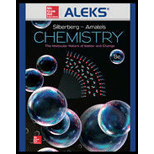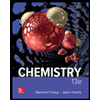
CHEMISTRY:MOLECULAR NATURE...-ALEKS 360
8th Edition
ISBN: 9781259916083
Author: SILBERBERG
Publisher: MCG
expand_more
expand_more
format_list_bulleted
Question
Chapter 8, Problem 8.43P
Interpretation Introduction
Interpretation:
The electronic configuration and the orbital diagram of the first excited state of sodium are to be determined.
Concept introduction:
The electronic configuration of an element tells about the distribution of electrons in the atomic orbitals. It is used to predict the physical, chemical, electrical and magnetic properties of the substance.
The spectral lines are the lines in the spectrum due to absorption and emission of light at a particular frequency. These are used to identify the elements and therefore called the fingerprints of the elements.
Expert Solution & Answer
Want to see the full answer?
Check out a sample textbook solution
Students have asked these similar questions
For the following alkyne, complete the reaction sequentially (that is draw the intermediate that we can’t stop at) and then name (complete name) all 3 molecules.
Given the reaction sequence below, answer the following.
A. Provide the structure for A.
B. Provide the structure for B (pay attention to stereochemistry).
C. Provide the structure for C.
D. What are the stereochemical designations for I and II (R/S)?
Which of the following is the most stable carbon radical?
Chapter 8 Solutions
CHEMISTRY:MOLECULAR NATURE...-ALEKS 360
Ch. 8.2 - Use the periodic table to identify the element...Ch. 8.2 - Prob. 8.1BFPCh. 8.2 - Prob. 8.2AFPCh. 8.2 - Prob. 8.2BFPCh. 8.3 - Prob. 8.3AFPCh. 8.3 - Prob. 8.3BFPCh. 8.3 - Prob. 8.4AFPCh. 8.3 - Prob. 8.4BFPCh. 8.3 - Prob. 8.5AFPCh. 8.3 - Prob. 8.5BFP
Ch. 8.4 - Prob. 8.6AFPCh. 8.4 - Prob. 8.6BFPCh. 8.4 - Prob. 8.7AFPCh. 8.4 - Prob. 8.7BFPCh. 8.4 - Prob. 8.8AFPCh. 8.4 - Prob. 8.8BFPCh. 8 - Prob. 8.1PCh. 8 - Prob. 8.2PCh. 8 - Prob. 8.3PCh. 8 - To test Döbereiner’s idea (Problem 8.3),...Ch. 8 - Summarize the rules for the allowable values of...Ch. 8 - Prob. 8.6PCh. 8 - State the exclusion principle. What does it imply...Ch. 8 - What is the key distinction between sublevel...Ch. 8 - Prob. 8.9PCh. 8 - Prob. 8.10PCh. 8 - Prob. 8.11PCh. 8 - How many electrons in an atom can have each of the...Ch. 8 - Prob. 8.13PCh. 8 - How many electrons in an atom can have each of the...Ch. 8 - Prob. 8.15PCh. 8 - State Hund’s rule in your own words, and show its...Ch. 8 - Prob. 8.17PCh. 8 - For main-group elements, are outer electron...Ch. 8 - Prob. 8.19PCh. 8 - Prob. 8.20PCh. 8 - Prob. 8.21PCh. 8 - Prob. 8.22PCh. 8 - Write the full ground-state electron configuration...Ch. 8 - Prob. 8.24PCh. 8 - Prob. 8.25PCh. 8 - Prob. 8.26PCh. 8 - Prob. 8.27PCh. 8 - Draw a partial (valence-level) orbital diagram,...Ch. 8 - Prob. 8.29PCh. 8 - Draw a partial (valence-level) orbital diagram,...Ch. 8 - Draw the partial (valence-level) orbital diagram,...Ch. 8 - Prob. 8.32PCh. 8 - Prob. 8.33PCh. 8 - Prob. 8.34PCh. 8 - Prob. 8.35PCh. 8 - Prob. 8.36PCh. 8 - How many inner, outer, and valence electrons are...Ch. 8 - How many inner, outer, and valence electrons are...Ch. 8 - Prob. 8.39PCh. 8 - Prob. 8.40PCh. 8 - Prob. 8.41PCh. 8 - Prob. 8.42PCh. 8 - Prob. 8.43PCh. 8 - Prob. 8.44PCh. 8 - If the exact outer limit of an isolated atom...Ch. 8 - Given the following partial (valence-level)...Ch. 8 - In what region of the periodic table will you find...Ch. 8 - Why do successive IEs of a given element always...Ch. 8 - Prob. 8.49PCh. 8 - Prob. 8.50PCh. 8 - Prob. 8.51PCh. 8 - Prob. 8.52PCh. 8 - Prob. 8.53PCh. 8 - Prob. 8.54PCh. 8 - Prob. 8.55PCh. 8 - Prob. 8.56PCh. 8 - Prob. 8.57PCh. 8 - Prob. 8.58PCh. 8 - Prob. 8.59PCh. 8 - Prob. 8.60PCh. 8 - Prob. 8.61PCh. 8 - Prob. 8.62PCh. 8 - Prob. 8.63PCh. 8 - Prob. 8.64PCh. 8 - Prob. 8.65PCh. 8 - What is a pseudo-noble gas configuration? Give an...Ch. 8 - How are measurements of paramagnetism used to...Ch. 8 - Prob. 8.68PCh. 8 - Prob. 8.69PCh. 8 - Prob. 8.70PCh. 8 - Prob. 8.71PCh. 8 - Prob. 8.72PCh. 8 - Prob. 8.73PCh. 8 - Prob. 8.74PCh. 8 - Prob. 8.75PCh. 8 - Prob. 8.76PCh. 8 - Prob. 8.77PCh. 8 - Prob. 8.78PCh. 8 - Prob. 8.79PCh. 8 - Prob. 8.80PCh. 8 - Which of these atoms are paramagnetic in their...Ch. 8 - Prob. 8.82PCh. 8 - Prob. 8.83PCh. 8 - Write the condensed ground-state electron...Ch. 8 - Prob. 8.85PCh. 8 - Prob. 8.86PCh. 8 - Rank the ions in each set in order of increasing...Ch. 8 - Prob. 8.88PCh. 8 - Prob. 8.89PCh. 8 - Prob. 8.90PCh. 8 - Prob. 8.91PCh. 8 - A fundamental relationship of electrostatics...Ch. 8 - Prob. 8.93PCh. 8 - Prob. 8.94PCh. 8 - Prob. 8.95PCh. 8 - Prob. 8.96PCh. 8 - Prob. 8.97PCh. 8 - Prob. 8.98PCh. 8 - Use Figure 8.16, to find: (a) the longest...Ch. 8 - Prob. 8.100PCh. 8 - Prob. 8.101PCh. 8 - Prob. 8.102P
Knowledge Booster
Similar questions
- Put the following carbon radicals in order of increasing stability.arrow_forwardDraw the major organic product for each of the following reactions (pay attention to stereochemistry).arrow_forwardThere are 2 reactions (that you know of) to achieve the following transformation: One reaction is favored over the other because it avoids a competing reaction. A. Draw the favored reaction scheme (not the mechanism), be sure to include all necessary reagents. B. Draw the reaction scheme that is not favored and include all the possible products.arrow_forward
- Both carbocations and carbon-radicals have trigonal planar geometry. True or Falsearrow_forwardTeflon (polytetrafluoroethene) is prepared via the radial polymerization of tetrafluoroethene. What other reaction conditions (reagent, etc.) are needed to accomplish this? A. NBS, Light B. Heat, Cl2 C. Peroxide, Heat D. H2SO4, H2O, Heatarrow_forwardWhich of the following compounds can be reacted with ethene to prepare 1,1- dichlorocyclopropane? A. CCl4 B. CCl2 C. CHCl3 D. CH2Cl2arrow_forward
- CI 4. How are the products of the following reaction related? (assuming we can control the chlorination as given by the reaction) C Cl2, light A. Enantiomers B. Constitutional isomers C. Regioisomers D. Diastereomers C +arrow_forwardVinyl and allyl radicals are equally stable due to resonance stabilization True OR Falsearrow_forwardAll of the following are true of Markovnikov’s rule EXCEPT A. The nucleophile adds to the most substituted carbon B. The more stable carbocation is formed in the transition state C. The electrophile adds to the carbon that has the most hydrogens D. There are no exceptions to this rulearrow_forward
arrow_back_ios
SEE MORE QUESTIONS
arrow_forward_ios
Recommended textbooks for you
 ChemistryChemistryISBN:9781305957404Author:Steven S. Zumdahl, Susan A. Zumdahl, Donald J. DeCostePublisher:Cengage Learning
ChemistryChemistryISBN:9781305957404Author:Steven S. Zumdahl, Susan A. Zumdahl, Donald J. DeCostePublisher:Cengage Learning ChemistryChemistryISBN:9781259911156Author:Raymond Chang Dr., Jason Overby ProfessorPublisher:McGraw-Hill Education
ChemistryChemistryISBN:9781259911156Author:Raymond Chang Dr., Jason Overby ProfessorPublisher:McGraw-Hill Education Principles of Instrumental AnalysisChemistryISBN:9781305577213Author:Douglas A. Skoog, F. James Holler, Stanley R. CrouchPublisher:Cengage Learning
Principles of Instrumental AnalysisChemistryISBN:9781305577213Author:Douglas A. Skoog, F. James Holler, Stanley R. CrouchPublisher:Cengage Learning Organic ChemistryChemistryISBN:9780078021558Author:Janice Gorzynski Smith Dr.Publisher:McGraw-Hill Education
Organic ChemistryChemistryISBN:9780078021558Author:Janice Gorzynski Smith Dr.Publisher:McGraw-Hill Education Chemistry: Principles and ReactionsChemistryISBN:9781305079373Author:William L. Masterton, Cecile N. HurleyPublisher:Cengage Learning
Chemistry: Principles and ReactionsChemistryISBN:9781305079373Author:William L. Masterton, Cecile N. HurleyPublisher:Cengage Learning Elementary Principles of Chemical Processes, Bind...ChemistryISBN:9781118431221Author:Richard M. Felder, Ronald W. Rousseau, Lisa G. BullardPublisher:WILEY
Elementary Principles of Chemical Processes, Bind...ChemistryISBN:9781118431221Author:Richard M. Felder, Ronald W. Rousseau, Lisa G. BullardPublisher:WILEY

Chemistry
Chemistry
ISBN:9781305957404
Author:Steven S. Zumdahl, Susan A. Zumdahl, Donald J. DeCoste
Publisher:Cengage Learning

Chemistry
Chemistry
ISBN:9781259911156
Author:Raymond Chang Dr., Jason Overby Professor
Publisher:McGraw-Hill Education

Principles of Instrumental Analysis
Chemistry
ISBN:9781305577213
Author:Douglas A. Skoog, F. James Holler, Stanley R. Crouch
Publisher:Cengage Learning

Organic Chemistry
Chemistry
ISBN:9780078021558
Author:Janice Gorzynski Smith Dr.
Publisher:McGraw-Hill Education

Chemistry: Principles and Reactions
Chemistry
ISBN:9781305079373
Author:William L. Masterton, Cecile N. Hurley
Publisher:Cengage Learning

Elementary Principles of Chemical Processes, Bind...
Chemistry
ISBN:9781118431221
Author:Richard M. Felder, Ronald W. Rousseau, Lisa G. Bullard
Publisher:WILEY